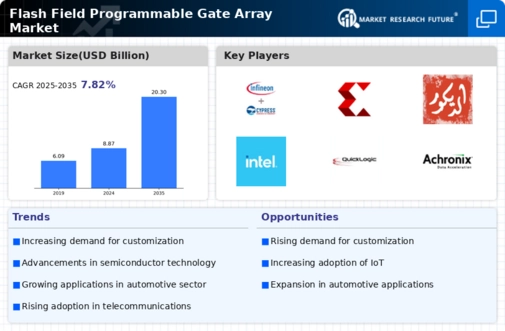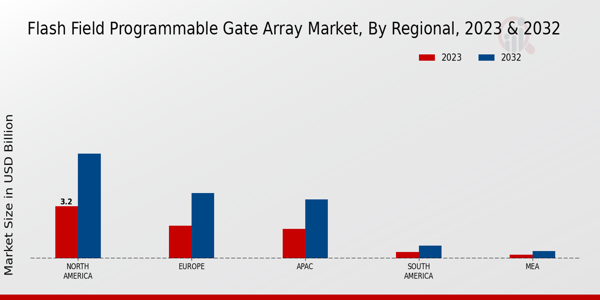Advancements in Technology
Technological advancements play a pivotal role in propelling the Global Flash Field Programmable Gate Array Market Industry forward. Innovations in semiconductor manufacturing processes and design methodologies have led to enhanced performance, reduced power consumption, and increased integration capabilities. These advancements enable flash FPGAs to support more complex applications, including artificial intelligence and machine learning. As the industry evolves, the market is expected to witness a compound annual growth rate of 7.82% from 2025 to 2035, potentially reaching 20.3 USD Billion by 2035. This growth is indicative of the increasing reliance on sophisticated hardware solutions in various sectors.
Increased Focus on Edge Computing
The rise of edge computing is reshaping the landscape of the Global Flash Field Programmable Gate Array Market Industry. As organizations seek to process data closer to its source, the demand for efficient, low-latency processing solutions has intensified. Flash FPGAs offer the necessary flexibility and performance to handle real-time data processing at the edge, making them an attractive option for industries such as manufacturing, healthcare, and smart cities. This trend aligns with the broader shift towards decentralized computing architectures, which are expected to drive significant growth in the market as organizations prioritize efficiency and responsiveness.
Growing Adoption in Telecommunications
The telecommunications sector significantly contributes to the expansion of the Global Flash Field Programmable Gate Array Market Industry. With the ongoing rollout of 5G networks, there is a heightened need for flexible and efficient hardware solutions that can support high-speed data transmission and low latency. Flash FPGAs are particularly well-suited for this purpose, as they can be reconfigured to optimize performance for different network conditions. This adaptability is crucial for telecommunications providers aiming to enhance service delivery and maintain competitive advantages. The increasing investment in telecommunications infrastructure further underscores the market's growth potential.
Rising Demand for Customizable Solutions
The Global Flash Field Programmable Gate Array Market Industry experiences a surge in demand for customizable solutions across various sectors. Industries such as telecommunications, automotive, and consumer electronics increasingly require tailored hardware solutions to meet specific performance and functionality needs. This trend is driven by the growing complexity of applications that necessitate flexibility in design and rapid prototyping capabilities. As a result, the market is projected to reach 8.87 USD Billion in 2024, reflecting a robust growth trajectory. The ability of flash FPGAs to be reprogrammed post-deployment allows companies to adapt to evolving technological requirements, further enhancing their appeal.
Emerging Applications in Automotive Sector
The automotive sector is increasingly recognizing the potential of flash FPGAs, contributing to the growth of the Global Flash Field Programmable Gate Array Market Industry. With the advent of advanced driver-assistance systems (ADAS) and autonomous vehicles, there is a pressing need for reliable and adaptable hardware solutions. Flash FPGAs can be utilized for real-time data processing and sensor fusion, enabling vehicles to make informed decisions based on their environment. As automotive manufacturers invest in innovative technologies to enhance safety and performance, the demand for flash FPGAs is likely to rise, further propelling market growth.













